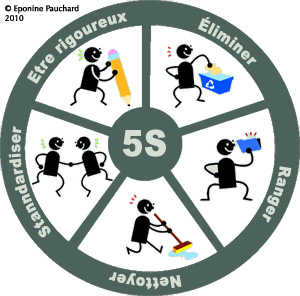How long does it take you to find an email or a document? Whether in our professional or personal lives, the massive production and sharing of documents and emails makes us victims of disorganization. I will first explain how digital 5S can help you regain control of your email boxes and hard drives. And most importantly, how you can become more efficient.

First, let’s get something straight. The day you decide to implement a digital 5S of your virtual files, it’s going to take some time. Depending on the status of your files, the scope of your project and the number of people involved, it takes from 1 to 3 days to complete such a project.
This time is the same as for classic 5S on a physical site. When a company launches a 5S project at the scale of a 500-person plant, it takes a few days of work to achieve the final result.
I advise you to start your digital 5S with a small area. You can choose your personal document folder, a completed project folder or one of your mailboxes. As with any 5S project, if you think too big, you’ll burn out.
Also, by starting small, you will be able to test different ways of doing things. For example, if the classification method you have defined is not adequate, you will not have to use it for all your files, but only the one you have chosen.
For details and tips on the 5S in the real world, read: The 5S, much more than a trend.

Launch of the digital 5S project
Start by choosing your playing field:
- A project and all its related documents and emails
- A specific folder
- A part of the team
- The cross-sector members of a project
I suggest that you begin the workshop with a short training session to explain the principles and process of the workshop. Whether you are doing 5S alone or in a team, take the time to define the scope, your goal and your deadline and post it.
There are no favourable winds for those who do not know where they are going.
Seneca (4 B.C. – 65 A.D.) Roman stoic philosopher, playwright and statesman
For example: By Thursday, we will do the digital 5S of the team’s “Administrative” directory. We will reduce its volume by 30%, the number of documents by 40%. The hierarchy will have 3 levels. We want to reduce the number of document requests to the deputy by 70%.
Seiri (整理) / Sort
As in the industrial world, this step is more difficult for some people than for others. However, the rules are the same: we don’t keep anything “just in case”. The criteria for elimination are similar. The discovery of an old document that “could have been used” does not make it useful. If no one knows it’s there, it means it doesn’t exist! In addition, the search functions can help to find documents with a large volume, duplicates, or the date of last access to a document.
Remember to measure the size of the directory or the number of documents before you start. Otherwise, you will not be able to measure your result!
Seiton (整頓) / Set in order
What storage method will you use? It is essential to have only one type of organization: by function, by date, by individual, by project, … If you sort your invoices by date and your quotes by customer, you increase the complexity and the time required to find a document. There is no single organization. It is up to you to judge according to your needs, habits and preferences. One of the constraints that can be set is the hierarchy of the file system. Thus, beyond three or four levels, the complexity becomes important. The number of clicks increases too much for comfort and hinders efficiency.
Before creating your folders, draw your organizational architecture and test it on a whiteboard: where does such and such a document go? If everyone has the same answer it is a sign that it is intuitive and meets the needs. Plus this activity can be fun depending on how you set it up.
Remember that files are alive: where does the work in progress go? You can create specific folders to store work in progress or versions of a document that you want to keep for the duration of the project. Temp” or “Archives” folders are easy to delete at the end of the project.
Seiso (清掃) / Shine
The cleaning step is easier in virtual mode: emptying the recycle garbage can takes only a few seconds. It is important to empty the trash of all disks and mailboxes. Another step in the cleanup is to delete all empty folders. If the search for empty folders can be done during the 5S project, it is in the rigor that the cleaning continues, with the deletion of empty folders each time they are encountered. Outdated documents should also be removed from time to time.
At the mailbox level, the spam box and the outbox must be cleaned: duplicates and messages that do not add value or do not require follow-up can be deleted.
Seiketsu (清潔) / Standardize
Creating a standard is easier when there are few people involved. At the team level, several types of standards can be deployed:
- the way files and directories are named: date, reference number, project code, document title, initials of creator/last reader …
- architecture of a new file for a client, project, individual, …
- privileged tool for sharing files or validating documents: emails, common directory, …
Shitsuke (躾) / Sustain
Once the workshop is completed, it must be followed up, as in all 5S, it is the team that carried it out and that uses the documents that must maintain it. The defined standards can help to maintain, but at the beginning, it is especially the audits, led by the management, which will anchor the practice. The audit grid is based on the standards and on the same kind of questions as a real 5S: is the area clean? Is the recycle bin emptied? Is the office tidy? Are there any documents that “stick out” from the files?
Another solution is to set aside time to do a regular update at the end of a week, month or project.
Maintaining the digital 5S is everyone’s business, whether it is to maintain it or to make it evolve.
